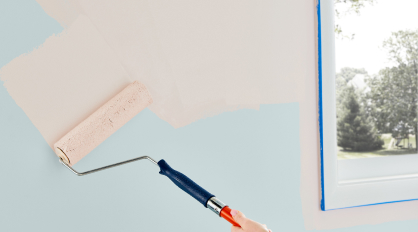You probably encounter oil-based paint when renovating older homes. It was popular decades ago because it’s tough, self-levels, and creates a flawless finish. For those reasons, painters favored it for high-impact areas like trim, cabinets, and doors. Today, however, many property owners don’t want to use oil-based paint for various reasons. So, as your customers lean more towards water-based and latex paints, you can discover how to successfully paint over oil-based paint with these tips and tricks.
Benefits of Water-Based Paint
If you’ve ever shaken a salad dressing to get the oil and vinegar to blend, you can understand why water-based paint and oil-based paint don’t stick to each other. One is made with a water solvent, the other with oil. And with advances in technology, water-based paint can now perform as well as oil-based in most applications, and it has many benefits.
It has a lower VOC content.
Since it produces fewer fumes, you can use it in occupied spaces.
Water-based paint saves natural resources and requires less energy to produce.
It cleans well with soap and water.
It adheres well to most substrates and produces a high film thickness.
In addition, water-based paint is preferred when covering an oil-based product because it has a faster drying time and resists fading in the sunlight for exterior applications.
How to Paint Over Oil-Based Paint with Water-Based Paint
Since adhesion is the main problem when covering oil-based paint, you must properly prepare the surface. But first, make sure you know what the existing paint covering is. Do this by rubbing the surface with a cloth moistened with denatured alcohol. If it picks up the color, the paint is water-based. If not, it’s oil-based. To prep an existing oil-based coating, follow these steps:
Make sure the existing coat is fully cured. If the coating is over seven to 30 days old and can be scrubbed without affecting the finish, consider it cured.
Use fine-grit sandpaper (180-220 grit) to remove the gloss from the surface. Scrape off any chipped or peeling paint and fill cracks or dents with wood putty.
Once the filler is dry, sand it smooth with the fine-grit paper.
Remove all the sanding dust by rubbing lightly with a tack cloth. Beeswax gives tack cloth its tackiness. If you press too hard, you could leave some of the wax behind.
Use a sponge to thoroughly clean the surface with a solution of a ¼ cup trisodium phosphate (TSP) in a gallon of warm water. Always use TSP in a well-ventilated area and wear personal protective equipment. For optimal paint adhesion, cover the oil-based paint with a high-quality primer such as those listed below. If any color or stains show through, apply a second coat of primer.
Under optimal conditions, these BEHR® primers listed below are ready for topcoat after one hour. Once completely dry, apply one to two coats of the desired BEHR water-based topcoat. Allow two hours of dry time in between coats.
Tips for Painting Over Oil-Based Paint with Oil-Based Paint
You may have reasons to use oil-based paint. For superior coverage on trim and doors of high-traffic areas, surfaces subject to high levels of moisture, or exterior applications, some painting professionals choose an oil-based covering. So, if you’re painting over oil-based paint with more oil-based paint, here are a few tips to consider.
Make sure the existing coat is fully cured. If the coating is over seven to 30 days old and can be scrubbed without affecting the finish, consider it cured.
If the existing natural oil-based coating hasn’t cured, only use a natural oil-based paint to cover it.
To cover an alkyd paint that hasn’t cured, use an alkyd or a natural oil-based paint.
Ideal Primers and Topcoats for Painting Over Oil-Based Paint
Behr Paint Company’s highly-rated, award-winning paints deliver superior value and transform any space into one of beauty. With Behr’s premium-quality paints and primers, you’ll find a wide range of colors that offer dependability and durability for interior and exterior applications. When painting over oil-based paint, consider the following BEHR® products:
BEHR® Multi-Surface Stain-Blocking Primer & Sealer
Use BEHR Multi-Surface Stain-Blocking Primer & Sealer on properly prepared, uncoated, and previously painted interior and exterior surfaces. Its styrene-acrylic formula resists medium to heavy stains and adheres to a wide variety of surfaces including wood and metal. In addition, BEHR Multi-Surface Stain-Blocking Primer & Sealer helps resist peeling and corrosion, making it a great option for different types of projects.
BEHR® Bonding Primer
BEHR Bonding Primer is specifically formulated to adhere to ‘tough-to-paint’ surfaces, providing a strong foundation for topcoats with little need to sand dense and glossy surfaces. Use under epoxies, lacquers, and products containing xylene or other hot solvents when allowed to dry for 24 hours before topcoating. Also, always test in an inconspicuous area before applying a full coat.
BEHR® Acrylic-Alkyd Enamel Undercoater
BEHR Acrylic-Alkyd Enamel Undercoater flows and levels similar to oil-based primers – which helps create a smooth topcoat appearance – but with easy soap and water clean-up. It also blocks tannin stains, making it an excellent choice for cabinet and door projects.
BEHR MARQUEE® Exterior Paint & Primer
BEHR MARQUEE Exterior Paint & Primer is our most advanced paint and primer. It delivers exceptional durability and provides a tough, non-stick surface that resists dirt. Its UV protection resists fading and retains gloss. In addition, BEHR MARQUEE Exterior Paint & Primer withstands early rain, blocks stains, and has an antimicrobial, mildew-resistant finish. This high-performing paint can be applied in low temperatures and guarantees a one-coat hide in over 700 colors*.
BEHR® primers and topcoats offer the dependability you need to paint with confidence. To learn more about painting over oil-based paint, contact your BEHR® Pro Rep.
*Valid only when tinted to colors from the One-Coat Hide Color Collection.

Tips on Painting Over Oil-Based Paint